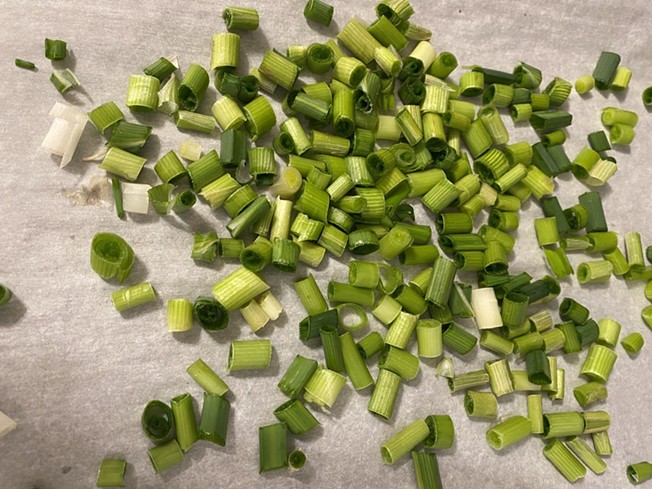A handy guide to foraging, cleaning, and cooking with wild garlic
Learn how to identify and use these pungent plants that grow throughout the Pittsburgh region. A guide to foraging, cleaning, and cooking with wild garlic is compiled by author Laura Kohn. Kohn learned about wild garlic from her backyard, living near North Park, near North Gate, and using it to create food for her family. Wild garlic is not safe for dogs to consume, but similar to garlic found in grocery stores and garden centers that acts as a blood purifier, digestive stimulant, and reduces bad cholesterol. The guide also provides best practices for cleaning, cooking, drying, and preserving wild garlic. The author suggests that an organic lawn can be as healthy and pristine-looking as a chemically treated one.

Published : a month ago by Stacy Rounds in Lifestyle
When the great isolation of 2020 started, my friend and former boss joked that we should write “apocalypse resumes” highlighting our practical and survival skills in case society imploded. I considered this, jokingly at first, but after learning to bake bread and make homemade wet wipes out of necessity — while watching the leader of our nation suggest drinking bleach on TV — I started to consider my survival skills more seriously.
I’ve enjoyed dehydrated wild garlic bits in ramen, stir fry, and smashed potatoes. Fresh wild garlic can also be substituted for store-bought garlic or ramps in just about any garlic butter recipe.
Like with any allium plant, wild garlic is not safe for dogs to consume. Luckily for me, my dog isn't interested in eating it. However, allium canadense does have similar
— the garlic you see every day in grocery stores and garden centers
— which works as a blood purifier, digestive stimulant, and reducer of bad cholesterol.
Having this tool in my arsenal may not save me from the apocalypse, but it is a fun bullet point to place in my post-society resume.
I decided to learn how to forage. And the best place to start was my backyard.I live on a three-quarter acre parcel near North Park, close to neighbors, trees, and plentiful wildlife. The previous owner of my home never chemically treated the yard. My neighbors refer to him as “an old hippie,” and I’m stoked that he was.Everyone has their own opinions about lawns and weeds. I don’t mind weeds and prefer indigenous plants to chemically treated, perfectly manicured grass. An organic lawn can be just as healthy and pristine-looking as a chemically treated one, according to the Green Grandma blog. And I feel better about my kids and dog rolling around in dirt and worms instead of Roundup.One of the first and most obvious edibles I found growing in my yard was wild garlic. This particular varietal, called allium canadense, produces rich, green tube-like stems similar to chives. They’re easy to identify since they tower over the grass and stink like onions.Before cultivating and consuming wild garlic, I did some Googling to ensure safety. In that process, I learned about the spread of these “weeds,” how to contain them, and best practices for cleaning, cooking, drying, and preserving them.Wild garlic looks similar to two toxic plants. The first is death camas, which are deadly to humans and most animals. However, death camas do not typically grow in Pennsylvania, preferring warmer, humid climates.The other similar-looking greens you’ll want to avoid are daffodil shoots. Newly budded daffodil stems, when consumed, can cause diarrhea, vomiting, and severe abdominal pain. Neither of the two toxic plants has the telltale pungent odor of wild garlic, making them easier to avoid while foraging.The first year I was in my house I was stoked to find edible onions in the backyard. However, the next spring season, I realized these plants had spread, completely taking over my side yard.Wild garlic spreads aggressively. On rare occasions, these plants produce flowers and seeds, though most spread by producing bulblets atop the hollow stems or reproducing their bulbs underground. Aerial bulblets form in late spring, terminal (replacement) bulbs form in early summer, and multiple offset bulbs form underground in early fall.Because these plants are so hardy, remaining green through harsh winters, they’re essentially the die-hard of weeds. Trying to pull them from the surface will prove both frustrating and futile. Rather, you’ll need to dig them up and remove all the bulblets from the ground.Since we’re not dealing with pesticides, it’s easy enough to wash wild garlic in cool water to rinse off the dirt or any critters that may be hiding out in the roots or stems. I made the mistake of washing these in my kitchen sink (pictured) and then had to scrub dirt from every crevice of my home. Then I found this video that shows a homesteader not only soaking them in a bowl outside to remove the dirt (wish I would have thought of that), but also making some kick-ass garlic honey.Before and during the cutting process, remove the outer skins. They peel easily, saving you time with cleaning. Any brown or dead ends will easily peel off as well. I like to separate the bulbs and stems, cutting the stems into fine bits with my kitchen scissors.Then, the sky’s the limit with preparing and preserving wild garlic. To dehydrate wild garlic, spread finely chopped green stems on a baking sheet lined with parchment, and place them in the oven on warm (160-180 degrees) for 20-40 minutes. Or you can spread them on a plate lined with a paper towel to air dry overnight.
Topics: Food & Drink
